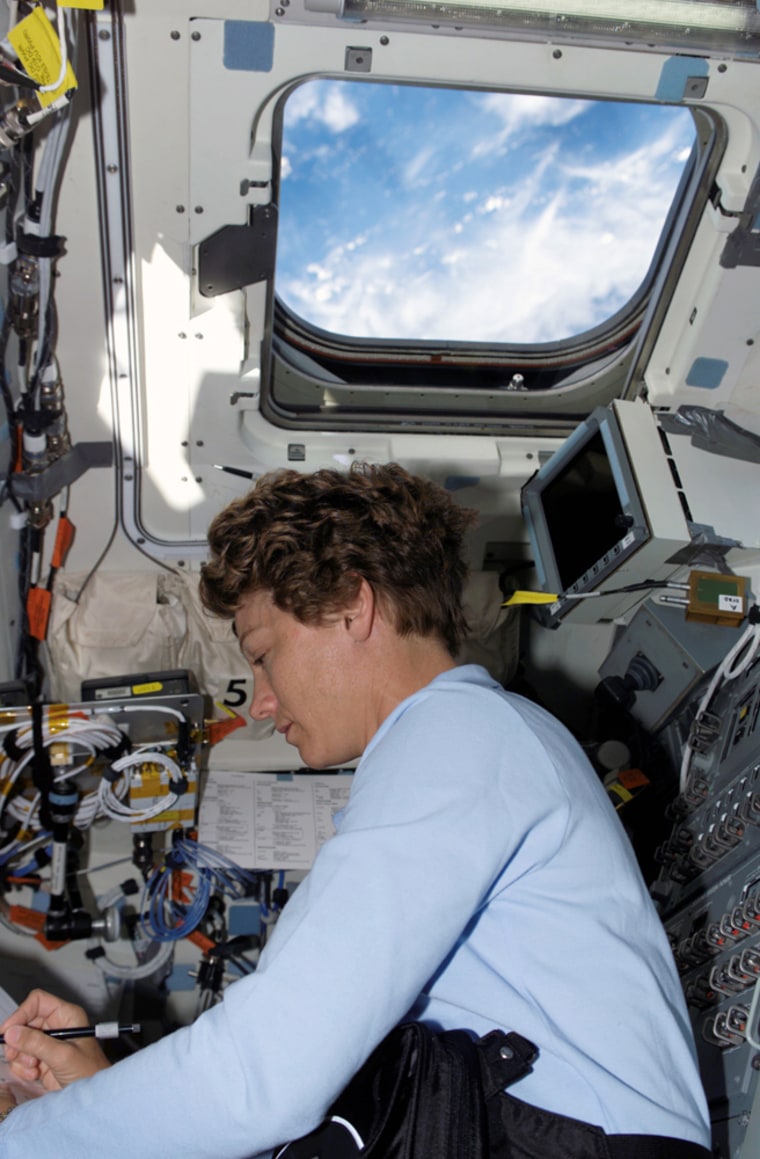Eileen Collins, commander of the shuttle Discovery and the only mother on board, has been sending messages every day from space to her young son and daughter.
The messages are calm and reassuring, “telling them what I’m doing and telling them that I love them and that I miss them and not to worry about us.”
Nine-year-old Bridget is old enough to think about what happened to the Columbia astronauts. But her dad has shielded her and her 4-year-old brother Luke as much as possible from some of the periodically unsettling news that has come during Discovery’s mission.
“I don’t want them to be worried,” said Collins’ husband, Pat Youngs, an airline pilot.
It’s been an emotional and bumpy ride for the families of Discovery’s astronauts, “almost like a soap opera,” Youngs said.
Unlike past missions where there were no cameras showing every little ding and chip in orbit, Discovery has been under magnified scrutiny as the first shuttle to fly after the loss of Columbia in 2003. And that’s meant some frightening information for families to absorb.
Youngs is satisfied that all of the shuttle problems have been addressed, and he’s confident of a safe homecoming for his wife and her six crewmates.
Nonetheless, his daughter knows about the big piece of foam that came off Discovery’s fuel tank during liftoff, and she has watched the mission’s spacewalks on NASA TV, including the one to repair Discovery’s thermal shielding.
“But I haven’t gone into great detail, these three pieces broke off and these four sensors showed something,” Youngs told reporters. “It’s our job, as any parent, to be honest, but we also feel everything’s in good shape.”
Youngs, who flies Boeing 767s for Delta Air Lines, has been apprehensive each time his wife has returned from space, and he expects the re-entry to be no different.
Information tough to digest
Astronaut Wendy Lawrence’s stepfather also expects to be nervous.
“In light of the fact that the previous shuttle was a disaster, of course there’s some level of anxiety. This is a very dangerous environment, and NASA knows that,” said Ralph Haynes of Junction City, Ore.
All the information pouring down from Discovery day after day — from a brand new inspection boom and wing sensors and an unprecedented amount of photography — has been tough for family members to digest, even for Youngs, a pilot. It’s all part of the extra checks for damage.
Each problem has seemed to be followed by another.
Besides the foam insulation lost during Discovery’s July 26 launch, there were two jutting strips of thermal tile filler that engineers feared might lead to another Columbia-type catastrophe. A spacewalking astronaut plucked the strips from Discovery’s belly on Wednesday.
Then a torn blanket under a cockpit window came under scrutiny for fear it might turn into deadly shrapnel during descent. Experts deemed it safe enough to leave alone.
And there have been countless other warts to worry over — chips in tile, small, possible dings in the wings. In the past, these would have been unnoticed.
Tougher on families than astronauts
It’s one thing for astronauts to deal with this level of detail — they’re mostly test pilots and Ph.D. engineers and scientists who signed up knowing the risks of spaceflight.
It’s another thing for their families.
Discovery’s co-pilot, James Kelly, said before the flight that he expected the shuttle’s trip home to be especially tough on his wife and four children this time around, because of that awful day in February 2003 when seven astronauts died.
Youngs takes comfort in all the analysis and testing that NASA has done for each of Discovery’s problems. “That’s a lot different than going in a back room and, ‘What do you think? What do you think? OK, three say don’t do it, two say do it. OK, we’re not doing it at all.”’
NASA analysis or no, astronaut Charles Camarda’s 80-year-old mother, Ray, has been fretting throughout the 13-day mission — and long before.
“I’m an old-fashioned Italian mom,” she said from New York City. “I have everybody in the world praying for him.”
Camarda chuckled when told of his mother’s remarks.
“I’m sure if you ask any other mother, they would feel exactly the same way,” he said.
Camarda’s wife, Melinda, found herself calling experts from the list her husband left behind, every time a new problem surfaced. As soon as she got some information, she passed it along to her mother-in-law to ease her mind. It was also a comfort to get her husband’s reassuring e-mails from orbit, she said Friday, since he’s an expert in thermal structures.
Reliance on prayer
Like Camarda’s mom, Collins’ father, James, 79, a retired postal worker in Rochester, N.Y., is relying on prayer. “God will take care of them, and she’s going to be back,” he said.
Astronaut Stephen Robinson, the spacewalker who repaired Discovery’s thermal shield, said his parents in Moraga, Calif., might be more worried “if they relied only on the news media, which tends to emphasize the negative.”
Instead, they have been listening to NASA.
Collins said she appreciates all the prayers — from President Bush to strangers around the world. “We thank you for caring for us,” she said in an interview with The Associated Press on Thursday.
“We ask also that you pray for our space program overall because it is a great thing for people all over the Earth. ... We believe in it and that’s why we are doing this.”
